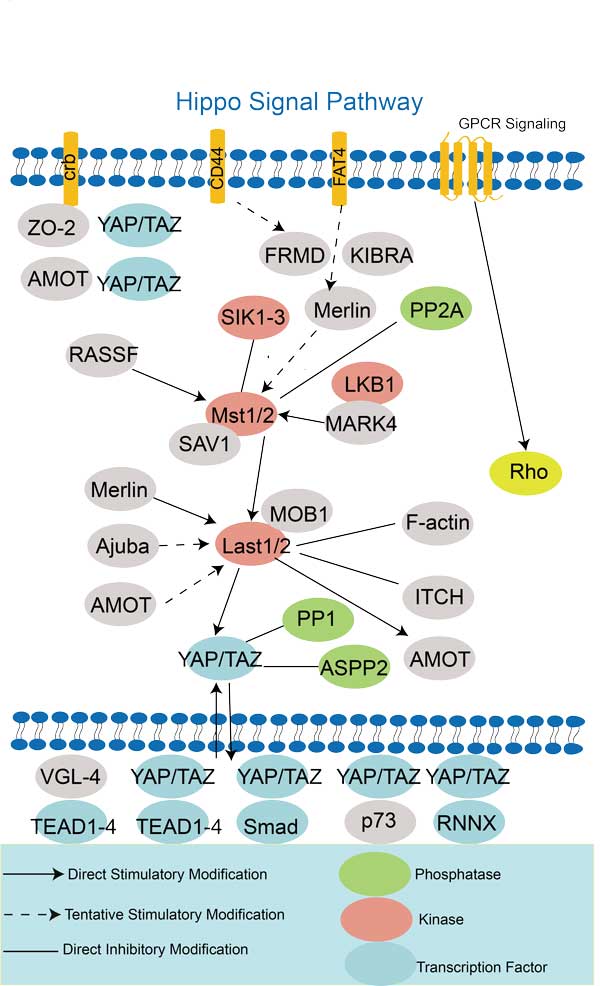YAP1
-
Official Full Name
Yes-associated protein 1 -
Overview
This gene encodes a downstream nuclear effector of the Hippo signaling pathway which is involved in development, growth, repair, and homeostasis. This gene is known to play a role in the development and progression of multiple cancers as a transcriptional regulator of this signaling pathway and may function as a potential target for cancer treatment. Alternative splicing results in multiple transcript variants encoding different isoforms. [provided by RefSeq, Aug 2013] -
Synonyms
YAP1;Yes-associated protein 1;YAP;YKI;YAP2;YAP65;yorkie homolog;yes-associated protein 2;65 kDa Yes-associated protein
Recombinant Proteins
- Human
- Mouse
- Rat
- Chicken
- Zebrafish
- E.coli
- Mammalian Cells
- Wheat Germ
- HEK293
- Yeast
- In Vitro Cell Free System
- GST
- His
- DDK
- Myc
- Non
- Avi
- Fc
- B2M
- Flag
Background
What is YAP1 Protein?
YAP1 gene (Yes1 associated transcriptional regulator) is a protein coding gene which situated on the long arm of chromosome 11 at locus 11q22. This gene encodes a downstream nuclear effector of the Hippo signaling pathway which is involved in development, growth, repair, and homeostasis. This gene is known to play a role in the development and progression of multiple cancers as a transcriptional regulator of this signaling pathway and may function as a potential target for cancer treatment. The YAP1 protein is consisted of 504 amino acids and YAP1 molecular weight is approximately 54.5 kDa.
What is the Function of YAP1 Protein?
YAP1 is a transcriptional coactivator encoded by genes downstream of the Hippo signaling pathway. It plays an important role in organ development, tissue regeneration, tumor formation and tumor metastasis. By interacting with TEAD (TEA domain family member) transcription factor family members, YAP1 co-regulates gene expression, thereby affecting cell proliferation, differentiation and migration. The function of YAP1 is strictly regulated by the Hippo signaling pathway, and when this pathway is activated, YAP1 is phosphorylated and retained in the cytoplasm, or promoted to degrade, thereby inhibiting its transcriptional activity. The YAP1 gene encodes a variety of protein isomers that may influence cellular behavior through different mechanisms, including interacting with specific proteins and activating unique transcriptional programs.
YAP1 Related Signaling Pathway
YAP1 is one of the main effector molecules of the Hippo signaling pathway. When the pathway is activated, YAP1 is phosphorylated and retained in the cytoplasm. When the Hippo signaling pathway is turned off, YAP1 is dephosphorylated and transferred to the nucleus, activating gene expression that promotes cell growth and survival. YAP1 can regulate the Wnt/β-catenin signaling pathway by interacting with β-catenin, and promote the occurrence and development of tumors. YAP1 can affect the TGF-β/Smad3 signaling pathway, and its activity in tumor cells may affect cell proliferation and metastasis. YAP1 can interact with a variety of transcription factors, such as TEAD family members, p73, etc. Through these interactions, YAP1 is involved in regulating gene expression.
YAP1 Related Diseases
Abnormal activation of YAP1 has been associated with a variety of diseases, especially with tumor development, including hepatocellular carcinoma, non-small cell lung cancer, breast cancer, and gastric cancer. In these diseases, overactivation of YAP1 can promote cell proliferation, metastasis, and invasion, and is associated with self-renewal and treatment resistance of tumor stem cells, thus affecting disease prognosis and treatment response. In addition, the abnormal expression of YAP1 is also associated with non-neoplastic diseases such as heart disease and pulmonary fibrosis.
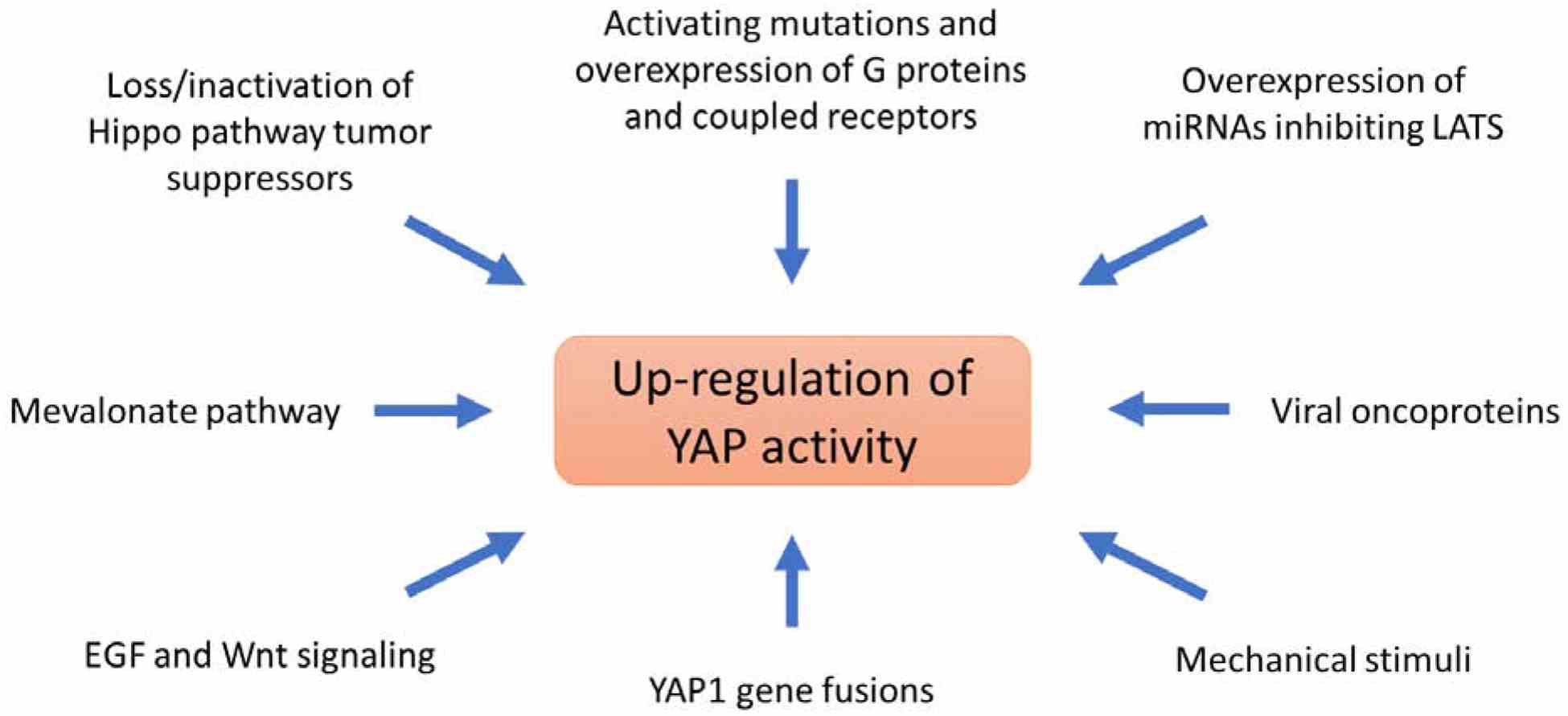
Fig1. Mechanisms of YAP1 de-regulation in cancer. (Frank Szulzewsky, 2021)
Bioapplications of YAP1
As a key effector molecule in the Hippo signaling pathway, YAP1 plays an important role in tumor development, and its abnormal activation in a variety of cancers makes it a potential target for cancer therapy. Yap1-related applications are focused on developing small molecule inhibitors or targeted therapy strategies for YAP1 to inhibit tumor cell proliferation, invasion, and metastasis while restoring tumor cell sensitivity to chemotherapy, radiation, and targeted therapy. In addition, the active status or expression level of YAP1 is also being investigated as a biomarker for certain cancers to aid in disease surveillance, prognostic assessment, and personalized treatment decisions.
Case Study
Case Study 1: Arunima Mondal, 2024
ACE2, a recently discovered molecule structurally homologous to ACE, has been reported to be beneficial in reducing the effect of RAS driven pathologies. In vivo diabetic mouse model was used and co-labelling immunostaining assay have been performed to analyse the fibrotic remodeling and involvement of associated target signaling molecules in mouse heart tissue. For in vitro analyses, qPCR and western blot experiments were performed in different groups for RNA and protein expression analyses. The results showed that hyperglycemia induced overexpression of YAP1 leads to increased expression of β-catenin (CTNNB1) and ACE with downregulated ACE2 expression.
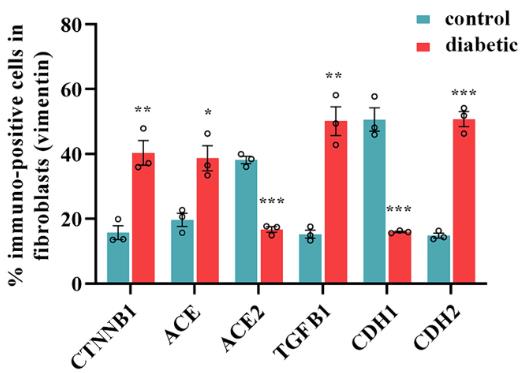
Fig1. Similar expression of YAP1was observed in the cardiac fibroblast cells co labelled with vimentin marker.
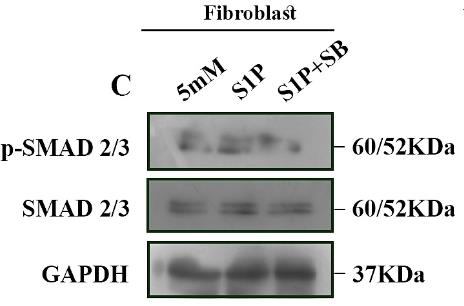
Fig2. Western blot images showing YAP1 activation mediated expression of p-SMAD2/3 over NG cells and expression following SB treatment.
Case Study 2: Teppei Sunaguchi, 2023
This study aimed to elucidate whether hyperglycemia promotes PC cell progression and whether aPKC activation is related to PC cell progression mechanisms. Researchers examined whether high-glucose stimulation accelerates PC cell proliferation, migration, and invasion. Furthermore, to determine whether PC cells activate aPKC upon high-glucose stimulation, they measured the phosphorylation of aPKC at T560 in PC cells. The results showed aPKC reportedly induces cell transformation through Yes-associated protein (YAP) activation. YAP expression was increased in high glucose-treated PC cells but not in aPKC-knockdown cells. Over-expression of Par-3 and aPKC-dominant negative mutants prevented the high glucose-stimulated nuclear localization of YAP. YAP forms a complex with the zinc finger E-box binding homeobox 1 protein (ZEB1), an activator of epithelial-mesenchymal transition.
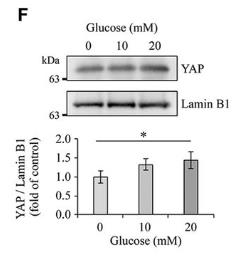
Fig3. MIA PaCa-2 cells were incubated for 24 h with or without high-glucose treatment and the expression levels of YAP and LaminB1 in the nuclear fractions were determined by western blotting.
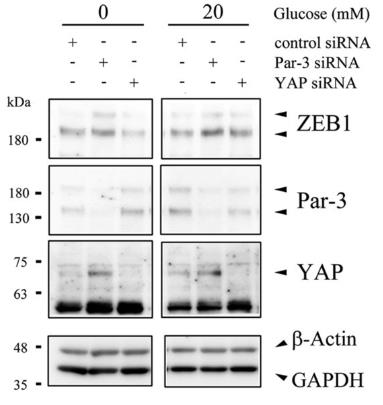
Fig4. YAP- or Par-3-knockdown MIA PaCa-2 cells were incubated and the expression of ZEB1, Par-3, and YAP was examined using western blotting.
Quality Guarantee
High Purity
.jpg)
Fig1. SDS-PAGE (YAP1-1556H)
.
.jpg)
Fig2. SDS-PAGE (YAP1-600H)
Involved Pathway
YAP1 involved in several pathways and played different roles in them. We selected most pathways YAP1 participated on our site, such as ErbB4 signaling events,Fatty acid, triacylglycerol, and ketone body metabolism,Gene Expression, which may be useful for your reference. Also, other proteins which involved in the same pathway with YAP1 were listed below. Creative BioMart supplied nearly all the proteins listed, you can search them on our site.
| Pathway Name | Pathway Related Protein |
|---|---|
| Metabolism of lipids and lipoproteins | ARSJ,PMVK,GPAT2,MED22,CHKA,ARSF,CERS3B,ACOT9.2,ARSH,ACOT9.1 |
| Generic Transcription Pathway | CTGF,ZNF485,ZFP1,ZNF664,ZNF180,NR2C2,ZNF383,JUNB,NR1H3,ZNF468 |
| Hippo signaling pathway | SOX2,TGFB2,WNT7A,GDF5,WNT16,TEAD3,BIRC2,BMP2,BMPR1B,WWC1 |
| ErbB4 signaling events | WWOX,CBFA2T3,WWP1 |
| Fatty acid, triacylglycerol, and ketone body metabolism | ACOT9.1,GLIPR1,CPT1B,ELOVL1A,THEM5,ACOT12,MED8,G0S2,MED22,CTGF |
| Nuclear signaling by ERBB4 | PRLRB,GHRB,CSN2,CSH1,CSHL1,WWOX |
| Metabolism | APOBB.1,AGL,B3GAT2,COL4A3BP,FIG4,TACO1,PEMT,ACOT10,NUDT4B,CKBA |
| Gene Expression | EIF2S1A,NR2C2AP,SLC38A8,COX4I1,NFIX,ARHGEF38,DDX4,ZNF496,GATAD2A,RBM5 |
Protein Function
YAP1 has several biochemical functions, for example, RNA polymerase II core promoter sequence-specific DNA binding,chromatin binding,proline-rich region binding. Some of the functions are cooperated with other proteins, some of the functions could acted by YAP1 itself. We selected most functions YAP1 had, and list some proteins which have the same functions with YAP1. You can find most of the proteins on our site.
| Function | Related Protein |
|---|---|
| transcription regulatory region DNA binding | FOXH1,MSX2,H2AFY2,HMGB2,MZF1,NR1D1,HIVEP2A,EGR2,AIRE,GATA5 |
| protein C-terminus binding | MLLT4,SAE1,XRCC5,PLEKHB1,SIAH1A,STIP1,ECM1,SIRT1,PRDX3,BCAM |
| transcription coactivator activity | TFDP1B,THRAP3,NR2C2,EP300,VGLL2,STIL,RXRA,MED13,NR5A1,JUNB |
| transcription factor activity, RNA polymerase II transcription factor binding | SRF,ATF4,THRAA,NACC2,MYOCD,TWIST2,GATA4,LHX2,GTF2E1,MAMSTR |
| proline-rich region binding | FAM59A,CSK,ABL1,PFN1,ABI2,APBB1,GAREM,CCND1,PRPF40A,WBP4 |
| transcription corepressor activity | HOMEZA,HDAC7A,PBXIP1,SSX4,ATF5,SKOR1A,CBX4,SSX2,ZHX1,HAND1 |
| chromatin binding | KLF6A,SP100,POU5F3,NKX6-1,GATA1A,RBPJL,HMGB2B,GATA3,ARX,PELP1 |
| protein binding | RAMP1,ATF7,HIST1H2AH,MED20,EEF1D,HSP90AB1,NR2F1,KCNG3,H3F3B,ZBTB6 |
| RNA polymerase II core promoter sequence-specific DNA binding | GATA3,MAZ,STAT5A,TRP53,HNF4A,ZFP335,SMYD3,SOX11,H3F3A,SOX8 |
Interacting Protein
YAP1 has direct interactions with proteins and molecules. Those interactions were detected by several methods such as yeast two hybrid, co-IP, pull-down and so on. We selected proteins and molecules interacted with YAP1 here. Most of them are supplied by our site. Hope this information will be useful for your research of YAP1.
CTNNB1;TEAD1;LATS1
YAP1 Related Signal Pathway
Resources
Related Services
Related Products
References
- Jerhammar, F; Johansson, AC; et al. YAP1 is a potential biomarker for cetuximab resistance in head and neck cancer. ORAL ONCOLOGY 50:832-839(2014).
- Lindskog, C; Kuhlwilm, M; et al. Analysis of Candidate Genes for Lineage-Specific Expression Changes in Humans and Primates. JOURNAL OF PROTEOME RESEARCH 13:3596-3606(2014).
- Takatsume, Y; Maeta, K; et al. Enrichment of yeast thioredoxin by green tea extract through activation of Yap1 transcription factor in Saccharomyces cerevisiae. JOURNAL OF AGRICULTURAL AND FOOD CHEMISTRY 53:332-337(2005).
- Ramos, CW; Guldener, U; et al. Molecular analysis of the Saccharomyces cerevisiae YHR076w gene. IUBMB LIFE 50:371-377(2000).

